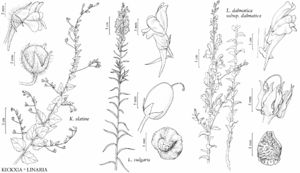Difference between revisions of "Linaria vulgaris"
Gard. Dict. ed. 8, Linaria no. 1. 1768.
FNA>Volume Importer |
FNA>Volume Importer |
||
| Line 42: | Line 42: | ||
--><p>Hybrids between <i>Linaria dalmatica </i>subsp.<i> dalmatica</i> and <i>L. vulgaris</i> (L. ×hybrida Schur) are found in California (Lassen Creek, Modoc County), Colorado (Jefferson County), Idaho (Coeur d’Alene Lake, Kootenai County), and Montana (Beaverhead-Deerlodge National Forest) (S. M. Ward et al. 2009). In these localities, both potential parental species are sympatric or nearly sympatric. Ward et al. confirmed that hybridization occurs between populations of <i>L. dalmatica</i> and <i>L. vulgaris</i>, and that the hybrid progeny are viable and fertile.</p> | --><p>Hybrids between <i>Linaria dalmatica </i>subsp.<i> dalmatica</i> and <i>L. vulgaris</i> (L. ×hybrida Schur) are found in California (Lassen Creek, Modoc County), Colorado (Jefferson County), Idaho (Coeur d’Alene Lake, Kootenai County), and Montana (Beaverhead-Deerlodge National Forest) (S. M. Ward et al. 2009). In these localities, both potential parental species are sympatric or nearly sympatric. Ward et al. confirmed that hybridization occurs between populations of <i>L. dalmatica</i> and <i>L. vulgaris</i>, and that the hybrid progeny are viable and fertile.</p> | ||
|tables= | |tables= | ||
| − | |references= | + | |references={{Treatment/Reference |
| + | |id=saner1995a | ||
| + | |text=Saner, M. A. et al. 1995. The biology of Canadian weeds. 105. Linaria vulgaris Mill. Canad. J. Pl. Sci. 75: 525–537. | ||
| + | }} | ||
}}<!-- | }}<!-- | ||
| Line 60: | Line 63: | ||
|distribution=Alta.;B.C.;Man.;N.B.;Nfld. and Labr.;N.W.T.;N.S.;Ont.;P.E.I.;Que.;Sask.;Yukon;Ala.;Alaska;Ariz.;Ark.;Calif.;Colo.;Conn.;Del.;D.C.;Ga.;Idaho;Ill.;Ind.;Iowa;Kans.;Ky.;La.;Maine;Md.;Mass.;Mich.;Minn.;Mo.;Mont.;Nebr.;Nev.;N.H.;N.J.;N.Mex.;N.Y.;N.C.;N.Dak.;Ohio;Okla.;Oreg.;Pa.;R.I.;S.Dak.;Tenn.;Tex.;Utah;Vt.;Va.;Wash.;W.Va.;Wis.;Wyo.;Europe;c Asia;introduced also in temperate regions of s South America (Argentina);Pacific Islands (New Zealand);Australia. | |distribution=Alta.;B.C.;Man.;N.B.;Nfld. and Labr.;N.W.T.;N.S.;Ont.;P.E.I.;Que.;Sask.;Yukon;Ala.;Alaska;Ariz.;Ark.;Calif.;Colo.;Conn.;Del.;D.C.;Ga.;Idaho;Ill.;Ind.;Iowa;Kans.;Ky.;La.;Maine;Md.;Mass.;Mich.;Minn.;Mo.;Mont.;Nebr.;Nev.;N.H.;N.J.;N.Mex.;N.Y.;N.C.;N.Dak.;Ohio;Okla.;Oreg.;Pa.;R.I.;S.Dak.;Tenn.;Tex.;Utah;Vt.;Va.;Wash.;W.Va.;Wis.;Wyo.;Europe;c Asia;introduced also in temperate regions of s South America (Argentina);Pacific Islands (New Zealand);Australia. | ||
|introduced=true | |introduced=true | ||
| − | |reference= | + | |reference=saner1995a |
|publication title=Gard. Dict. ed. | |publication title=Gard. Dict. ed. | ||
|publication year=1768 | |publication year=1768 | ||
|special status=Weedy;Introduced;Illustrated | |special status=Weedy;Introduced;Illustrated | ||
| − | |source xml=https://jpend@bitbucket.org/aafc-mbb/fna-data-curation.git/src/ | + | |source xml=https://jpend@bitbucket.org/aafc-mbb/fna-data-curation.git/src/f50eec43f223ca0e34566be0b046453a0960e173/coarse_grained_fna_xml/V17/V17_103.xml |
|genus=Linaria | |genus=Linaria | ||
|species=Linaria vulgaris | |species=Linaria vulgaris | ||
Revision as of 20:02, 16 December 2019
Perennials, reproducing vegetatively by adventitious buds from roots. Fertile stems erect or suberect, (25–)35–90(–120) cm; sterile stems to 18 cm, usually absent. Leaves of fertile stems: blade linear to linear-lanceolate, 4–68 × 1–7(–15) mm, apex acute. Racemes 11–31(–50)-flowered, usually dense, rachis glabrous or glandular-hairy, hairs 0.1–0.2 mm; bracts linear to lanceolate, 4–20(–25) × 1–2 mm. Pedicels erect, 3–7.7 mm in flower, 3.5–8(–13) mm in fruit. Calyx lobes lanceolate to ovate, 2.5–4.5 × 0.8–1.5 mm in flower, 2.5–5(–6) × 1–2(–2.5) mm in fruit, apex acute. Corollas white, pale yellow, or bright yellow, sometimes with orange palate, 27–32(–33) mm; tube 5.5–9(–10) mm wide, spurs straight or curved, 11–15 mm, slightly shorter or subequal to rest of corolla, abaxial lip sinus 3–3.5 mm, adaxial lip sinus (2.2–)2.4–4(–4.5) mm. Styles simple; stigma entire. Capsules oblong-globular or ovoid, 5–10(–11) × 3–6 mm, glabrous; loculi equal. Seeds gray, brown, or black, disciform, subglobular, with prominent encircling wing, 1.6–2.5(–3) × 1.5–2.3 mm, ± plane or biconvex; disc gray, brown, or black, ± reniform, tuberculate; wing ± entire, 0.4–0.7 mm wide, membranous, smooth. 2n = 12.
Phenology: Flowering May–Oct.
Habitat: Disturbed places, roadsides, railroad rights-of-way, rocky slopes, cultivated or abandoned fields, usually in moist or dry soils.
Elevation: 0–2300(–3100) m.
Distribution
Alta., B.C., Man., N.B., Nfld. and Labr., N.W.T., N.S., Ont., P.E.I., Que., Sask., Yukon, Ala., Alaska, Ariz., Ark., Calif., Colo., Conn., Del., D.C., Ga., Idaho, Ill., Ind., Iowa, Kans., Ky., La., Maine, Md., Mass., Mich., Minn., Mo., Mont., Nebr., Nev., N.H., N.J., N.Mex., N.Y., N.C., N.Dak., Ohio, Okla., Oreg., Pa., R.I., S.Dak., Tenn., Tex., Utah, Vt., Va., Wash., W.Va., Wis., Wyo., Europe, c Asia, introduced also in temperate regions of s South America (Argentina), Pacific Islands (New Zealand), Australia.
Discussion
Linaria vulgaris was introduced into the northeastern United States (New England) before 1672 as an ornamental and medicinal plant (M. L. Fernald 1905b). In part from vigorous formation of adventitious shoots from the roots (T. S. Bakshi and R. T. Coupland 1960), L. vulgaris is now considered a noxious weed in nine states and four Canadian provinces (E. A. Lehnhoff 2008).
Hybrids between Linaria repens and L. vulgaris are known as L. ×sepium G. J. Allman; this hybrid presents an intermediate morphology between L. repens and L. vulgaris with regard to corolla and spur size (16–21 mm and 6–9.5 mm, respectively). Specimens examined suggest that this hybrid is relatively common in Newfoundland.
Hybrids between Linaria dalmatica subsp. dalmatica and L. vulgaris (L. ×hybrida Schur) are found in California (Lassen Creek, Modoc County), Colorado (Jefferson County), Idaho (Coeur d’Alene Lake, Kootenai County), and Montana (Beaverhead-Deerlodge National Forest) (S. M. Ward et al. 2009). In these localities, both potential parental species are sympatric or nearly sympatric. Ward et al. confirmed that hybridization occurs between populations of L. dalmatica and L. vulgaris, and that the hybrid progeny are viable and fertile.
